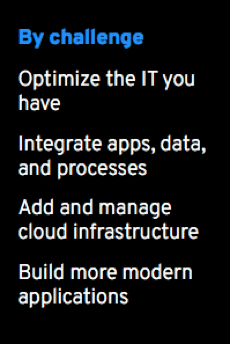Author: Marcia Riefer Johnston / Source: Content Marketing Institute

Does your company look at content through customers’ eyes? Here’s one way to tell: Look at your marketing content. For starters, riffle through some titles. Do the words typically convey customers’ concerns? Or do they mostly call attention to the things you sell?
If products hog the spotlight, you’re missing opportunities to build customer relationships and, ultimately, revenue. You’re also missing opportunities to streamline your content efforts throughout the organization, including distribution, management, and reuse.
The content team at Red Hat found this out first hand. A few years ago, the team took a hard look at the company’s content and found that it was heavily oriented toward what Red Hat sells (IaaS solutions, PaaS solutions, Linux solutions, and so on). The team discovered loads of diverse content that was hard to find, disorganized, difficult to reuse, and, most importantly, not customer-centric, says Red Hat’s marketing content curator and librarian Anna McHugh.
After the team looked at the content through the customers’ eyes, the path became clear. They created a framework around the audience’s challenges, reorganizing and tagging the content accordingly. They then decided which content to retire, which to refashion, which to create, and which not to create.
The content now better serves people inside and outside the company.
The results? “Promising,” Anna says. Although it’s impossible to tie the content overhaul directly to the company’s financial performance, she believes that the new focus on customer-oriented content contributed to Red Hat’s highest first-quarter revenue growth in four years. Revenue specific to emerging technology (including app development) – an area related to the top customer challenges that Anna’s team helped identify and address – grew year over year by 41% in the first quarter and 44% in the second quarter.
You don’t have to work for a technology company to adopt the Red Hat approach. What has worked for it could work for any company in any industry. Here’s what the team did:
- Identified the business challenges that keep its customers up at night
- Adjusted the content framework to reflect those challenges
- Tied the metrics to the adjusted framework
- Audited the content for gaps and filled those gaps
Drawing from emails with Anna and from her Content Marketing World talk, Beyond Traffic Reports: Using Data, Organizational Messaging, and Passion to Reinvigorate Your Content Strategy, this post sums up how the Red Hat content team did all this and how you can, too.
1. Identify the business challenges that keep your customers up at night
Before you can organize your content in customer-centric ways, you must identify your customers’ top challenges. For starters, Anna says, learn what you can from your sales team: “Sit down with them and say, ‘OK, what are you consistently seeing and getting questions about?’ That input helped us flesh out our customers’ business challenges and the use cases that fall under them.”
Based on conversations with Red Hat salespeople, customers, and partners, a cross-functional team (including the content team) evaluated the company’s buyer personas and came up with the top four challenges facing their customers and prospects. As Anna explains:
The evaluation was all about getting real-life feedback from potential Red Hat customers rather than relying on the formal personas to decide what to create and distribute. Our research also helped Red Hat refine and deepen its understanding of the personas and flesh them out.
Today, the four challenges inform not only the way the content teams plan and organize the content but also the way Red Hat’s sales and marketing teams talk with customers.
When people visit the Red Hat website and click “Technology,” they can quickly find content that will help them because they can navigate based on the challenge they’re facing.

If you wonder how a company can narrow its customers’ top challenges to four, keep in mind these are high-level challenges. Each contains a range of use cases. For example, within the challenge “build more modern applications,” the use cases vary. Startups and multinational enterprises, for instance, have separate issues related to building apps. “We create different content for each use case,” Anna says.
Anna isn’t suggesting marketers abandon product-oriented content. Every company needs to inform people about its products and services. Her point, she says, is:
For your sales and marketing to succeed, demonstrate empathy and understanding of your customer’s problems, and then kick off conversations with them about how you can help.
HANDPICKED RELATED CONTENT:
2. Adjust your content framework to reflect customers’ top challenges
After you determine your customers’ top challenges, align your content framework accordingly. By “content framework,” I mean the way your team thinks about your whole collection of content at the highest level, including the metadata used to categorize and otherwise tag content.
I’m talking about the behind-the-scenes way your team sees your content hanging together, the buckets it falls into. Before this initiative, Anna says, Red Hat had no metadata strategy to help people find useful, customer-relevant content:
It…
Audience Team
The digital audience insights you need to build, manage and market to your digital audiences.

